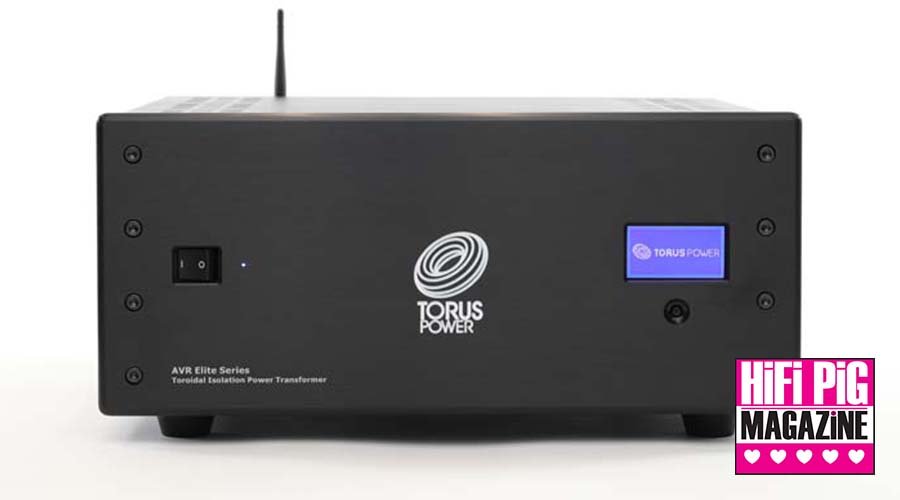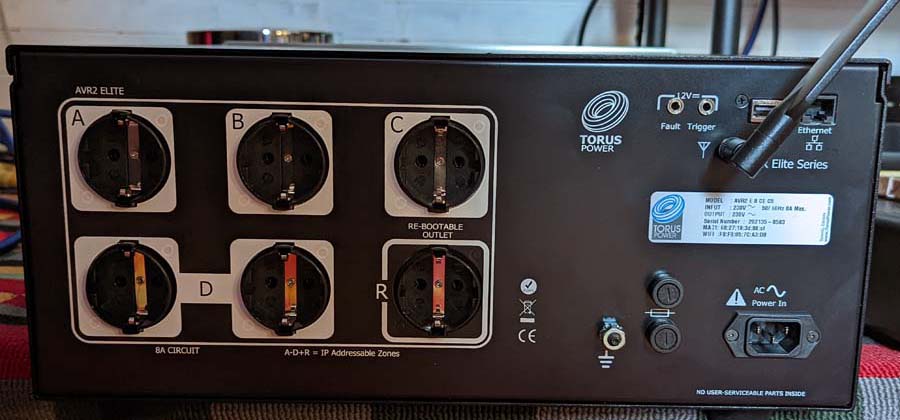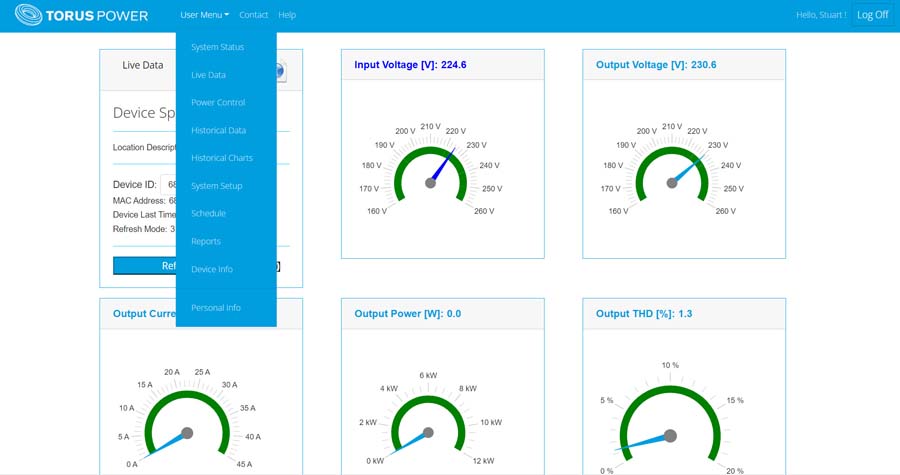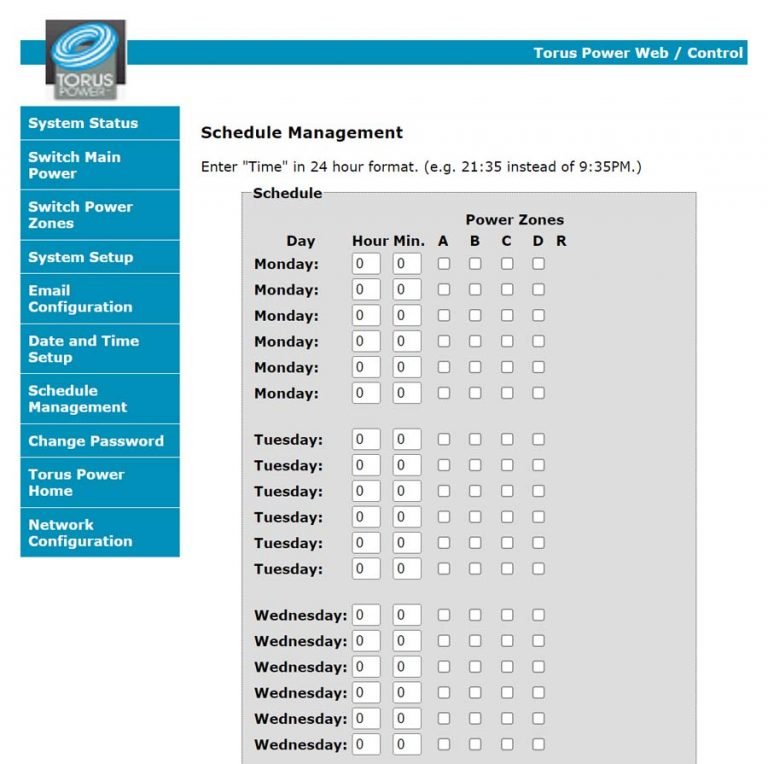The Torus Power AVR2 Elite 8 CE is a power “conditioner” based around a toroidal transformer to effectively isolate the power going to your audio gear. Stuart Smith ditches his Time Machine and takes a trip with the Torus.
Reprinted from HiFi PiG Magazine, June 22, 2022 – Readers who have been following my wafflings over the years will be aware that I’ve been a long-time advocate of something we affectionately refer to as the Time Machine. Said Time Machine is basically a big Toroidy mains transformer in a box with an input power socket and an output socket to which we connect a multi-plug adapter from Atlas. It works very well, but it looks a bit Heath Robinson (Rube Goldberg is the American equivalent) as it was indeed made by a friend.

Torus Power AVR Elite front. The Torus is a big unit but looks just like another component on the rack.
I tell pretty much anyone who will listen that this form of mains conditioning has clear sonic benefits and others who have followed suit have reported similar sonic paybacks. When Torus got in touch to ask me if I would like to have a play with one of their units I naturally jumped at the opportunity – I remember the first time I saw one of their units at a show with its clothes off and thinking that I’d really like to have a go with one in our system.
The package arrived on a palette and was heavy. Very heavy! But then given that this is, to bring it down to its basic level, a huge mains transformer in a very nice box, it was always going to be a beast! But that’s really not the whole story with the AVR 2 ELITE series of power transformers in that way over and above our little (it’s actually quite little but bloody heavy) Time Machine, the Torus Power AVR 2 is much more sophisticated in what it can do and what is in the box, though it should do the same kind of job.
Where the Torus differs from the Time Machine is in its level of sophistication, control, power handling, and other features – it’s even connected to the web. Yes, you could get by with one of the big industrial-looking mains transformers you can buy (and I do have one of these but it is so ugly that I have never bothered to wire it up) but then Torus has made their offering much more domestically acceptable, and where very few people would get away with an industrially cased transformer in their main listening room or any room for that matter, the Torus unit looks like a big power amp that will sit happily on your rack of choice – if it will take the weight.

Around the back and showing the sockets etc.
I said just now that the Torus looks like a big power amplifier and it does – I can well imagine that the casework could have doubled as a case for an amp. There’s a thick aluminium front plate with an on/off switch to the left, the Torus logo centre, and an LED screen to the right – that’s your lot. However, it’s round the back where the business end of the Torus lies. Common to all the Elite range there’s inputs for connecting to the network (more on this in a bit), plus a Wi-Fi antenna, a USB 2 port that can be used for charging phones or whatever, an earth post, a 12VDC trigger for turning the unit on or off, and a 12VDC fault output that comes into operation when a relay or voltage fault is detected. In addition to the connections mentioned, there are also 6 power sockets for connecting your kit. The outputs are labelled A, B, C, D, and R with D having two outlets in its “group”. In North America the power outlets on the AVR Elite are medical grade and on International units they are properly CE-certified outlets by Interpower. The grouping of the outlets is a clever feature of the Torus and the “groups” switch on in sequence; first A, then B, then C, and finally D. This means that you can have your power amp/s switch on last in the sequence when you fire up your rig for a listening session. The output R is designed specifically for plugging your network router into should you want to take advantage of the automatic reboot feature following an internet outage. If you don’t want to take advantage of this then it can be used as a regular socket that switches on last in the sequence previously outlined.
That LED on the front panel has a push-button underneath it that allows you to cycle through what is being displayed: Time and date, power status, IP/MAC address, system status, and active zones. If the system detects a fault (the voltage is too high or too low) the LED will display a fault message saying the system is off and whether this is due to a too high or too low voltage. If Torus does detect voltage is too high or low then it will shut off all the outlets until it detects that the voltage has been within the normal operating range for a full one minute at which point it will turn on each of the sockets in turn again. The range is pretty massive and for 230V the power has to fall below 160V or greater than 260V to trigger a fault response. Most folk will find everything they need on the LED!
The main features of the AVR Elite are:
-
- A toroidal transformer to provide clean power.
- Automatic voltage regulation to maintain a stable output voltage.
- Surge protection to protect against lightning, power surges, and spikes.
- Sequenced outlet zones. These are addressable and controllable via the online connection, but more on that in a bit.
- Internal flash memory to record up to 10,000 events.
One of the features that Torus Power were keen for me to know about was something they call NBT (Narrow Bandwidth Technology). Essentially what this does is balances the inherent inductance, capacitance, and resistance characteristics of the transformer so that it acts as a low pass filter and does away with the need for external filters such as capacitors. So what this means is that high-frequency noise on your electricity supply from fridges, dimmers, and whatnot is filtered out and a pure AC current results – NBT allows the 50 or 60Hz AC (low frequencies) to pass through unhindered but cuts noise by as much as 50dB.
There’s a load more features, but the ones that interest me are the ones above, though I am going to talk about the Torus Power Connect service and the online control and monitoring of the unit.
I wanted to get straight into what are for me the main features of the Torus which are running it as a power supply unit without all the online bells and whistles. This is the most basic way the Torus can be used in your system. Once wired to the mains and then to our kit you flick the switch, the LED lights up and then there’s a short wait and the relays switch on the outputs in turn – the LED display will let you know what outputs are on, the current draw etc. That’s it. One point of note is that once powered up the Torus is absolutely quiet. Also worthy of note is that the Torus has a circuit to limit the power rush into the unit when it is turned on. This latter feature is really useful as I have, in the past, managed to trip our main consumer unit when switching on the Time Machine.

A glimpse inside the Torus Power AVR2 Elite
If you want to (and you have paid for it and so you should) you can also connect the AVR Elite to your home network. To do this you need to run a network cable from your router (or switch in my case) to the Torus and follow some pretty basic instructions in the A4 handbook that comes with the unit. The handbook tells you just to type AVR into your web browser but I had to type in the IP address of the Torus unit which can be found by scrolling through the display on the front panel. Once connected you put in the provided username and password and up pops a control interface that allows you to prat about with all the main functions of your Torus unit and see the unit and what it is doing “live”. I hadn’t really been expecting to be excited by this feature and thought I’d be more than content just plugging the Torus in as a very basic unit and reviewing in that mode, but it’s actually pretty cool to be able to sit on your computer and play God from the comfort of your armchair.
The Torus Power Connect interface is somewhat more sophisticated and offers virtual dials to show output/input etc. and you get a five-year subscription with every unit you buy. However, I do think that when the novelty of this wears off you will much more likely just use the Torus AVR ELITE in its basic plug-n-play configuration or via the simple panel you access through your computer and your home network – ie. you’ll not bother opening TPC up. This cloud-based option is, according to Torus Power, primarily designed for custom home tech professionals who want to review and maintain their installed systems.
A screen-grab of the more in-depth Torus Power Connect Interface that will be of more use to those looking for monitoring and following data about their installations.

On the home network interface you can control and see:
System Status which tells you what the input and output voltages are, the current out and the power out put of the torus are at any given time. Switching on the Krell amp without music playing immediately saw the current output jump to 1.6A and 362W. It also allows you to switch zones on or off, and tells you if the unit is functioning normally or not and what the current software version is.
Switch Main Power which allows you to turn the main unit on or off.
Switch Power Zones to select which of the power outlet zones are on or off.
System Setup to activate auto-reboot and the reset delay time or to disable on zone R, and to control the dimming, etc of the front panel screen.
E mail Configuration where you can set up the email you want logged data etc to be sent. I didn’t bother with this and likewise didn’t change the date and time on the Date and Time Setup page.
Schedule Management throws up a screen of days of the week, times and power zones so you can program the unit to power up when you need it to. I don’t have set times to listen to music and so didn’t use this feature.
You then get a trio of pages that allow you to change your password, take you to the Torus Power homepage, and to mess about with the network configuration. Again, I saw no reason to mess with any of these but it will be useful for some people who want to schedule their kit coming on at specific times or just for those who are curious about what’s going on with their electricity and what the Torus Power unit is doing.
One thing I did notice was that there was not the option to update the software to the latest version, though when I asked about this Torus Power informed me that when a firmware update is available they will push it to a connected unit where the display will let the user know it is available and they can initiate its loading.
Here are a few screenshots of the simple network interface which is as in-depth as I’d want to get with the data and control.



For whatever reason, there was an audible hum through the speakers when I had everything plugged into the Torus. At this time I had the LAB 12 pre in the system. I tried every combination I could but for whatever reason, there was always a buzz with the LAB12 pre being plugged into the Torus. I switched the LAB12 pre (and DAC) out for the Leema Libra DAC/Pre and the system became deathly quiet – in a good way. I don’t know if this is some kind of conflict between the LAB12 and the Torus but it wasn’t there with the Time Machine and disappeared when I put the Leema into the system.
Sound Quality
I’m not going to do a massive write-up on sound quality for this review as I don’t think it’s needed for me to write about a hundred and one tunes I listened to and dissect them. I suppose it is more relevant to talk about the effect of the Torus being in the system in more general terms.
Using the Torus in the system as opposed to having no kind of power conditioning in the system is pretty much the same as when we have the Time Machine in the system – after all, they (despite the Torus having many more safety features, being able to handle bigger devices and being much more controllable) are pretty much doing the same thing. The effect is one of increasing the space around instruments in the mix and generally making things appear more three-dimensional. I have no idea why this is, and, as always with this kind of thing, I don’t really care what the cause is – it’s the effect I’m interested in. Overall there seems to be a more focused and, dare I say it clean sound, with small details in the mix appearing to be more noticeable. Sonically, this is one of those things that are hard to describe, but once you experience it there is no going back. The system is certainly quieter and this allows the music to be heard more precisely, I believe. Overall there is a feeling of there being more detail to the music you are listening to – and I don’t think it is a subtle improvement. The improvement is real and audible, and it does expand the experience of listening to the music to a higher level that will be of benefit to those looking to get the very best out of their system.
I had the Krell both into the Torus and plugged into the mains (I usually find it is better plugged straight into the mains and not into the Time Machine) and I found a sonic benefit of having it plugged into the Torus. In fact, I plugged in and unplugged everything including our switch etc (through a multi-plug strip plugged into the Torus in this case) and streamer, and without exception the improvement was there and clearly audible. However, the most dramatic improvements were with the amp, pre/DAC and phonostage (valve-based, but no issues).
Time Machine or Torus is the next question that I need to ask myself, and I’m afraid that the Torus wins out every time with regards to the improvement it brings – with the caveat that this wasn’t the case with the aforementioned pre. It’s not going too far to say that the Torus elevated our already excellent sounding system to a new level of fidelity!
Over and Above
As I said, the sonic effects of this unit and others like it are real and unquestionable, but that’s only half the story with the Torus AVR Elite. You are paying a premium here for the added benefits of being able to monitor what is happening in real-time, connectivity, programmability, and, importantly, the added safety features that the Torus has built-in.
Quibbles
Our valve-based LAB12 pre did not get on with the Torus and created an audible hum when plugged into it. Other valve kit did play nicely.
An iOS and Android app would be a useful addition and make control easier. However, the manual does show you how to add a shortcut to Torus Power Connect so that it can be easily accessed.
Conclusion
Apart from the issue I had with the LAB 12 preamplifier, the Torus AVR Elite is a hit – a big hit! In every permutation of our big system, it brought improvements over and above the system with no conditioning and with the Time Machine in the system – and I do love our Time Machine…or did.
The improvements I heard are not subtle, and whilst the Torus AVR Elite is not a cheap product the effect it brought to our system was big enough for me to contemplate getting one for permanent use. The main effect that I hear is more space between instruments and a cleaner presentation across the audio spectrum. There is also a dramatic effect on the overall noise floor with the Torus in the system which has an obvious effect.
I’ve been trying to think of a relevant analogy to putting the Torus in the system and the best I can come up with is that it’s like wearing glasses, being perfectly happy with your vision and then going and getting your new prescription and putting your new specs on.
I deliberated for a long time over the award I was going to give the Torus AVR Elite and I ended up not giving it our Editors Award based purely on the price. There is no doubting the efficacy of the unit (it’s brilliant), but that brilliance does come at a price that may well put it out of the reach of many – though other less pricey options are available from Torus Power.
At A Glance
Build Quality and Features:
-
- It’s built like the proverbial brick outhouse and, unsurprisingly given it has a massive transformer inside, weighs a ton
- Unlike the more industrial units that are available, this looks like another piece of audio kit on the rack
- Simple to set up and simple to program – should you wish to
- Zoning of outputs is useful
- Online monitoring and control of the AVR Elite is cool and pretty useful
Sound Quality:
Although the Torus Power AVR Elite doesn’t have a sonic imprint of its own, it does (very) positively affect the sound of your kit
I have experienced Power Transformers have a negative effect on (specifically) power amplifiers where they seem to constrict the sound at the upper frequencies – the Torus Power does not do this and the improvement of having it in the system was positive on every bit of kit bar the preamplifier I mentioned
A cleaner and more open sound is obvious, with the biggest benefits being to amplifiers, DACs and preamplifiers
Value For Money:
It’s not cheap by any stretch of the imagination, but it is a quality unit that is built for providing clean power to high-end audio systems and it should be seen in this light
We Loved:
- Build is excellent and it looks great on the rack
- The effect on sound quality is obvious and immediate
Being able to set up and control the AVR Elite is a cool feature, though I imagine that the majority of two channel users will simply plug it in and plug their kit into it
We Didn’t Love So Much:
- There’s no getting away from the fact that this is an expensive item
- For whatever reason, our valve pre didn’t get on with the Torus but the solid-state Krell benefitted greatly
Price: €9,900. €11,500. $12,500
Elevator Pitch Review: The Torus Power AVR2 Elite 8 CE is a sophisticated power management and conditioning unit aimed at those with high-end systems and who want to ensure it is fed with a clean and stable power supply. Whilst there is no denying that the unit we tested is expensive, it is clear that it works – and works very well. Whilst not having a sonic-signature of its own it does, I believe, allow the audio equipment you connect to it to perform at their optimum and this is born out in the enhancement of the music you listen to. The main improvements for me sonically were an improvement in the space around individual parts of the mix and a sense of everything being “cleaner” and detailed.

Stuart Smith, Author
